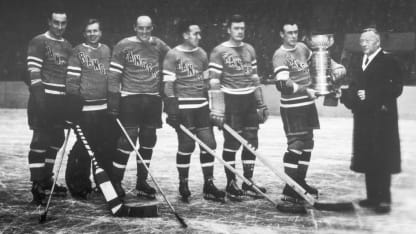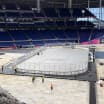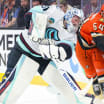Legendary hockey reporter Stan Fischler writes a weekly scrapbook for NHL.com. Fischler, known as "The Hockey Maven," shares his humor and insight with readers every Wednesday.
This week reaches back in New York Rangers history to the 1932-33 season, when a minor league goalie playing in the Bronx finally made it to Manhattan and helped New York to its second Stanley Cup championship.
His well-deserved nicknames were "The Glasgow Growler" and "The Best Goalie You Never Heard Of." His name is Andy Aitkenhead and he accomplished more in less time with the New York Rangers than others at his position who played a decade in the NHL.
In Aitkenhead's rookie season of 1932-33, the Scotland native helped the Rangers to their second Stanley Cup title, but after one more NHL season he disappeared so fast it seemed as if a magician used him in a hidden-goalie trick. Perhaps more astonishing is that for years Aitkenhead was buried in the minors, most recently with the Bronx Tigers of the Canadian American Hockey League, a crosstown Rangers farm club, in 1931-32.
"Andy didn't appear to have any NHL future," said George Grimm, author of "Guardians of The Goal -- A Comprehensive Guide To New York Rangers Goaltenders."
"Lester Patrick, who ran the Rangers, was set in goal with a highly regarded veteran, John Ross Roach."
Voted 50th by The Hockey News among the "Top 100 Goalies of All-Time," Roach was one of the most acrobatic and entertaining netminders of his era, except he inexplicably crashed in the 1932 Stanley Cup Playoffs.
"I have no idea what happened to Johnny," wrote teammate and future Hockey Hall of Famer Frank Boucher in his book "When the Rangers Were Young."
Facing the Toronto Maple Leafs in the 1932 Stanley Cup Final, Roach was the goat of the "Tennis Series." He lost 6-4, 6-2 and 6-4, and his job as Rangers goalie.
Seeking a replacement, Patrick realized all he had to do was take a nickel subway ride to the Bronx, where the Tigers were led by blond, blue-eyed Aitkenhead. Though Aitkenhead played well in the 16,800-seat Bronx Coliseum, he still was a minor leaguer in the Pacific Coast Hockey League whose best years were in Portland, Oregon, where he became a local hero.
Undaunted, Patrick signed Aitkenhead as his starter for the 1932-33 season.
"He was an acrobatic young man," Boucher said, "who sometimes wore a tweed cap when he played goal."
At first, Aitkenhead was mocked by the media. Reporter Marshall Hunt chided him as "a juvenile goalie." Then he sarcastically added, "I hope he doesn't get his skates tangled in the net too often."
Ignoring the critics, Aitkenhead made his NHL debut against the Montreal Maroons, a 4-2 win at the Montreal Forum on Nov. 10, 1932. John Halligan, Russ Cohen and Adram Raider, authors of the book, "100 Rangers Greats," noted, "Andy made some spectacular saves that even coaxed applause from the locals. He kicked off a magical year for himself and the club."
By midseason, Aitkenhead stilled all skeptics. The Rangers were 13-6 with four ties and in a neck-and-neck battle for first in the American Division.
"Aitkenhead's play was brilliant," wrote hockey historian Joe Pelletier in "Greatest Hockey Legends."
Aitkenhead carried the Rangers to the Stanley Cup in 1933 against the defending champions from Toronto. True to form, the rookie goalie won six of eight games with two shutouts. The press hailed him as an unexpected hero.
Writing in the Toronto Globe, sports editor Mike Rodden called Aitkenhead one of the playoff stars.
"He made many stops that were extraordinary," Rodden wrote. "On his showing in the playoffs, Andy must be rated with the best net guardians of the sport."
Henry McLemore of United Press International went a step further in evaluating the rookie: "This was the outstanding sports achievement of the year."
Nor did Aitkenhead endure a sophomore slump. During the 1933-34 regular season, he had seven shutouts -- including a pair of 0-0 games in December -- and a 2.27 goals-against average. While he was at it, he became a Madison Square Garden cult figure.
"He wears a dirty little hat that rides cockeyed on his head in every battle," McLemore wrote about Aitkenhead's fan appeal.
His teammates noted that he was becoming more intense than the average goalie.
"He refused to go to the movies for fear that it would hurt his eyes," McElmore said. "On non-game nights he'd be in bed by nine."
Inexplicably, Aitkenhead's game suddenly fell apart late in the season.
"The stress of playing goal in the NHL began to take its toll," Grimm wrote, "and in March 1934 he suffered what was called a 'nervous breakdown.'
"But Andy regained his composure and played the rest of the season and the playoffs. He played well in the postseason, giving up only two goals in a two-game total goals series against the Maroons, but the Blueshirts could score only one and were eliminated. By then, his nerves were shot."
Aitkenhead never fully recovered. He started the 1934-35 season but lost seven of his first 10 games. This time, Patrick's S.O.S. was answered by the Maroons, who sold the Rangers goalie Dave Kerr for $10,000.
"When I joined the Rangers, I was told that Andy got so … that he'd lock himself in his room after a game and play the game over and over," Kerr said. "By the time the next game rolled around, he'd played 48 games in that room."
Patrick dispatched Aitkenhead to the minors, where he mostly played for Portland in the PCHL. In 1987, he was inducted into the Oregon Sports Hall of Fame "for helping the original Portland Buckaroos build a fan base in The Rose City." He died at age 64 on Oct. 21, 1968.
Aitkenhead was 47-43 with 16 ties in 106 games for the Rangers. Although he long has been forgotten by fans, he is revered by goalkeeping historians who remain cognizant of his place in hockey annals.
"Even though he is one of just four goalies who have led the Rangers to the Stanley Cup," Grimm concluded, "it's fair to say that The Glasgow Growler really is the best goalie you never heard of!"


















